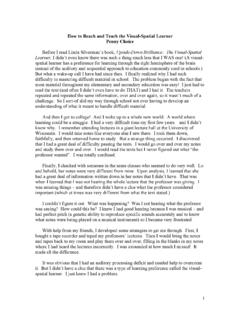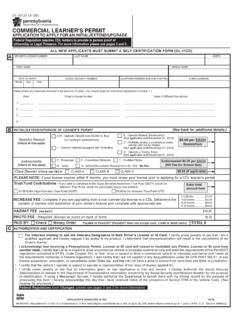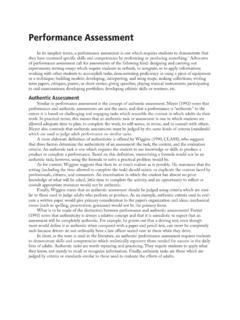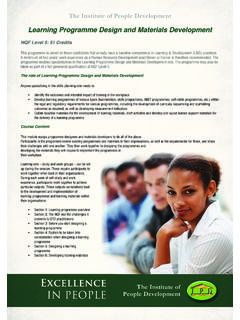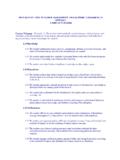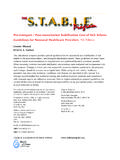Transcription of Learner guide - Yellow Media Publishers
1 Learner guide Learning Module 5: Produce, implement and evaluate assessment instruments and conduct appropriate follow-up after an assessment event SAQA QUAL ID20159 QUALIFICATION TITLE-National Diploma: ABET Practice NQF LEVEL: 05 Produce, implement and evaluate assessment instruments and conduct appropriate follow-up after an assessment event Learner guide Module 05 1 TRAINING INTRODUCTION WELCOME Welcome to the course! The Facilitator is here to assist you in learning and understanding what is required to successfully complete the course. You are encouraged to participate in all the exercises and ask as many questions as you like, that are pertinent to the course.
2 If you are uncomfortable with any aspect of the course, please feel free to discuss this with your Facilitator. Remember that the course meets SAQA requirements. INDUCTION We would like you to be comfortable throughout your learning, within a safe and healthy environment. Regular breaks are scheduled according to the course requirements and include tea / lunch time. You are requested to switch off your cell phone during lectures and the use of any form of digital camera (cell phone or other) is not allowed. If you are expecting and emergency, or urgent call, please discuss this with the Facilitator. COURSE FORMAT The Learner may also be requested to complete a Portfolio of Evidence in which practical work and exercises carried out in the workplace are recorded, written-up and evaluated.
3 The Learner will then be assessed Competent, or Not Yet Competent, using a variety of assessment tools which may include, Written Tests, Oral Tests, Assignments, Observations and Practical Role-plays. APPEALS This Appeal Process is a requirement of accreditation as a Training Provider and therefore is fully compliant with SETA norms. TRAINING IN SOUTH AFRICA SAQA (South African Qualifications Authority) oversee training in South Africa today and their authority extends over the complete spectrum of formal and informal learning in the classroom and the workplace. SETA s (Sectorial Education and Training Authorities) are responsible for developing education and training within defined commercial and industrial sectors of the workplace and general population.
4 To ensure uniformity in education and training, each sector has a SGB (Standards Generating Body) who scrutinize and accredit the individual Unit Standards submitted for approval within that particular sector. This SGB will allocate a Unit Standard to a level and allocate credits whilst also registering the Unit Standard with an Identity Number. The level allocated will be in accordance with the NQF (National Qualifications Framework) and the credits are based on an estimated learning period (1 credit = 10 hours of learning) DETAILS OF THIS COURSE Revise February 2016 Information Researched and developed by Yellow Media Publishers Group Produce, implement and evaluate assessment instruments and conduct appropriate follow-up after an assessment event Learner guide Module 05 2 Contents THE QUALIFYING Learner IS CAPABLE OF.
5 8 MODULE ALIGNMENT .. 8 TAKE NOTE .. 16 .. 20 SELECTING ASSESSMENT TOOLS .. 20 THE FOLLOWING IS AN EXAMPLE OF AN OBSERVATION ASSESSMENT 22 DEFINING YOUR PROGRAM AND EXPECTED LEARNING OUTCOMES .. 69 A) CLEARLY STATE PROGRAM MISSION AND GOALS .. 69 B) LISTING THE EDUCATIONAL OBJECTIVES FOR EACH GOAL .. 70 C) STATE CLEARLY THE LEARNING OUTCOMES YOU ARE SEEKING .. 71 2. ALIGNING PROGRAM COMPONENTS WITH LEARNING OUTCOMES .. 72 3. SELECTING AND IMPLEMENTING ASSESSMENT METHODS .. 73 4. USING EVIDENCE GATHERED IN ASSESSMENT .. 73 PREPARING learners FOR ASSESSMENT .. 74 ASSESSMENT RUBRIC .. 75 ASSESSMENT POLICY .. 76 FEEDBACK AND COUNSELLING .. 80 REPORTING .. 85 PRESENTATION.
6 88 .. 88 REASECH PROJECT .. 89 ACTIVITY : 06 .. 89 .. 89 SIMULATION .. 90 ACTIVITY : 07 .. 90 .. 90 REASECH PROJECT .. 99 ACTIVITY : 08 .. 99 .. 99 SIMULATION .. 100 ACTIVITY : 09 .. 100 Produce, implement and evaluate assessment instruments and conduct appropriate follow-up after an assessment event Learner guide Module 05 3 .. 100 HOW TO PERFORM SWOT ANALYSIS .. 103 REASECH PROJECT .. 104 ACTIVITY : 11 .. 104 .. 104 SIMULATION .. 105 ACTIVITY : 12 .. 105 .. 105 ALTERNATE MEANINGS .. 109 TYPES .. 109 INITIAL, FORMATIVE AND SUMMATIVE .. 109 OBJECTIVE AND SUBJECTIVE .. 111 BASIS OF COMPARISON .. 112 INFORMAL AND FORMAL .. 112 INTERNAL AND EXTERNAL .. 113 STANDARDS OF QUALITY.
7 113 RELIABILITY .. 113 VALIDITY .. 114 EVALUATION STANDARDS .. 115 SUMMARY TABLE OF THE MAIN THEORETICAL FRAMEWORKS .. 116 ROLE PLAY .. 119 .. 119 PRESENTATION .. 120 .. 120 REASECH PROJECT .. 121 ACTIVITY : 16 .. 121 .. 121 ASSIGMENT .. 125 .. 125 ROLE PLAY .. 126 .. 126 PRESENTATION .. 127 .. 127 REASECH PROJECT .. 128 ACTIVITY : 04 .. 128 .. 128 WHAT TO KNOW ABOUT GROUP DYNAMICS? .. 130 TRAINING 133 TEXTBOOKS .. 136 TEACHING AIDS .. 138 ACTIVITY .. 140 Produce, implement and evaluate assessment instruments and conduct appropriate follow-up after an assessment event Learner guide Module 05 4 SUPPLEMENTARY LEARNING MATERIALS .. 140 SIMULATION .. 149 ACTIVITY : 05.
8 149 .. 149 WRITING EFFECTIVE SENTENCES .. 152 .. 152 1. CONCISENESS IN SENTENCES .. 152 2. FLUENCY IN SENTENCES .. 155 3. EMPHASIS IN SENTENCES .. 156 4. MAKE SENTENCES CLEAR .. 158 REASECH PROJECT .. 162 ACTIVITY :08 .. 162 .. 162 LESSON PLANNING AND TOOLS .. 165 USEFUL TOOLS .. 166 TRAINER NOTE .. 168 HANDOUT 17A: WAYS VISUAL AIDS HELP PEOPLE LEARN AND REMEMBER .. 173 HANDOUT 17B: WHY PICTURES FAIL TO CONVEY IDEAS .. 181 HANDOUT 17C: DESIGN CONSIDERATIONS .. 186 HANDOUT 17D: USING PICTURES TO COMMUNICATE EFFECTIVELY .. 193 TRAINER ATTACHMENT 17A: WHY USE VISUAL AIDS? .. 196 TRAINER ATTACHMENT 17B: VILLAGERS TEACHING US TO TEACH THEM .. 199 TRAINER ATTACHMENT 17C: EXAMPLES OF A TEACHING SITUATIONS.
9 203 ASSIGMENT .. 205 .. 205 ROLE PLAY .. 206 .. 206 PRESENTATION .. 207 .. 207 REASECH PROJECT .. 208 ACTIVITY : 11 .. 208 .. 208 SIMULATION .. 209 ACTIVITY : 11 .. 209 .. 209 SUGGESTED READING & RESOURCES .. 211 Produce, implement and evaluate assessment instruments and conduct appropriate follow-up after an assessment event Learner guide Module 05 5 Structure of the Learner guide ELO US Type NLRD US Title Level Credits ELO Produce, implement and evaluate assessment instruments and conduct appropriate follow-up after an assessment event Core 10291 Design, implement and follow up on internal assessment for adult learners Level 5 12 Core 10290 Evaluate, select and adapt published learning materials and develop, use and evaluate own supplementary learning aids Level 5 12 TOTAL CREDIT VALUE 24 Note to learners Dear Learner .
10 Welcome to this Learning programme. We trust that this Learning programme will be of great value to you during your studies. To succeed in anything in life requires a lot of hard work. It will be expected of you to work through this study guide with a Produce, implement and evaluate assessment instruments and conduct appropriate follow-up after an assessment event Learner guide Module 05 6 Preface: The NQF allows for two exit points at Level 5: a Higher Certificate of 120 credits and a National Diploma of 240 credits. Although it is not compulsory to make use of both these exit points, the SGB decided that it is appropriate to do so. The decision was based on the Produce, implement and evaluate assessment instruments and conduct appropriate follow-up after an assessment event Learner guide Module 05 7 following contextual factors: a) There is very large demand in the ABET sector for a one year qualification, which approximates a Higher Certificate at Level 5 of 120 credits.
